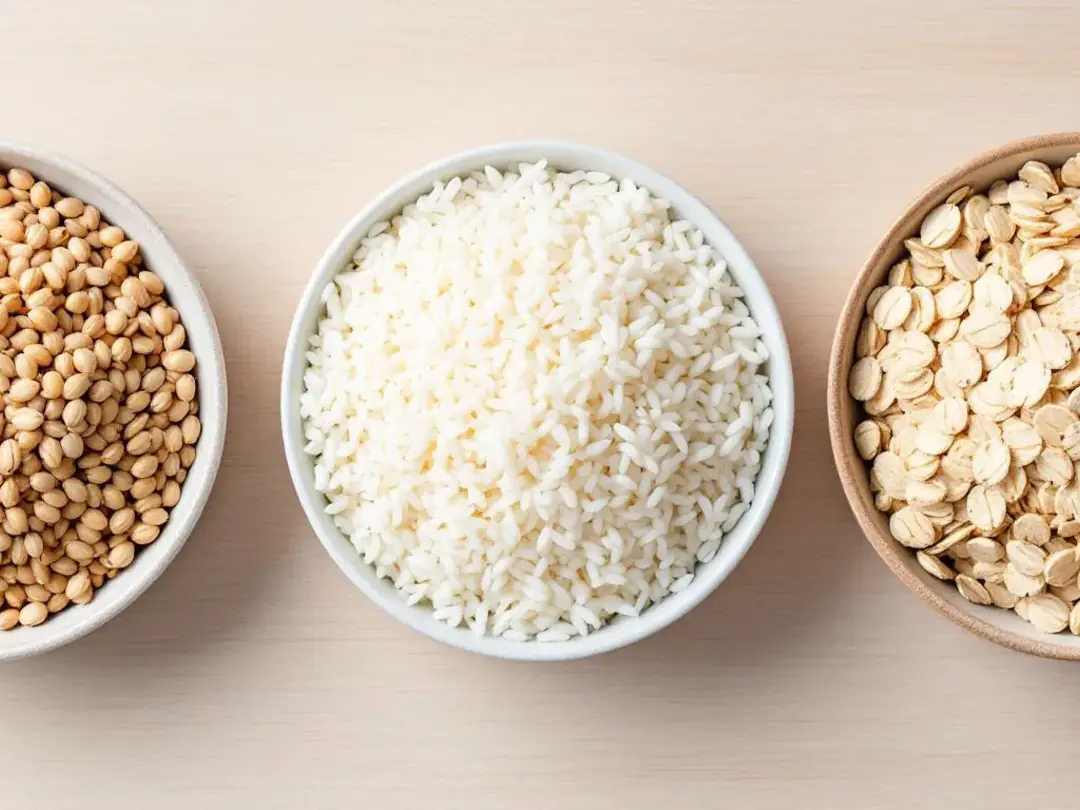Key Takeaways
-
Dogs can safely eat barley when it's properly cooked and served plain without seasonings or additives
-
Barley provides essential nutrients including fiber, protein, B vitamins, magnesium, phosphorus, and selenium that support overall canine health
-
Barley can support your dog's health by promoting well-being and energy, but should be fed in moderation and with attention to individual sensitivities
-
Limit barley to no more than 10% of your dog's daily caloric intake to prevent digestive issues and maintain nutritional balance
-
Dogs with gluten sensitivities should avoid barley since it contains gluten, and rice may be a better alternative for these pets
-
Always introduce barley gradually and consult your veterinarian before making significant dietary changes
Can Dogs Eat Barley? The Quick Answer
Yes, dogs can safely consume barley when it's properly prepared and given in moderation. This grain is commonly used as an ingredient in commercial dog food due to its nutritional benefits and digestibility. Barley serves as an excellent source of carbohydrates that complement meat-based proteins in a balanced canine diet.
The key is serving only cooked barley to your pet. To feed barley to your dog, offer small, measured portions and ensure it is thoroughly cooked and plain, as moderation and proper preparation are important for safe feeding. Raw barley is difficult for dogs to digest and should always be avoided. When you cook barley thoroughly with plain water, it becomes soft and easily digestible, making it safe for most dogs to enjoy.
Many pet parents successfully incorporate barley into their dog's diet as a healthy supplement. However, like any new food, it should be introduced gradually and monitored for any adverse reactions.


Nutritional Benefits of Barley for Dogs
Barley brings impressive nutritional value to your dog's health. The high fiber content supports healthy digestion and helps maintain regular bowel movements, which is essential for your pet's overall well being. Barley's insoluble fiber adds bulk to stool, helping in preventing constipation. This soluble fiber also helps your dog feel satisfied longer, potentially preventing overeating. Additionally, the soluble fibers in barley help support heart health and manage cholesterol and blood sugar levels.
The low glycemic index makes barley particularly beneficial for diabetic dogs or those managing weight issues. Unlike other grains that cause blood sugar spikes, barley releases energy slowly and steadily, helping regulate your dog's energy levels throughout the day. Barley's B vitamins and carbohydrates also help maintain your dog's energy levels, supporting their overall vitality and activity.
As a rich source of plant-based protein, barley supports muscle development and maintenance. While it shouldn't replace animal proteins in your dog's diet, it provides a valuable complement to meat-based foods. The grain also delivers essential B vitamins-barley is a good source of vitamin B, supporting energy metabolism, nervous system function, and other vital bodily functions.
The mineral content in barley is equally impressive. Your dog benefits from magnesium for bone health, phosphorus for strong teeth, potassium for heart function, and selenium for immune system support. Barley also contains other nutrients, such as additional vitamins and minerals, that contribute to your dog's overall health and well-being.
Research shows that barley may help lower LDL cholesterol levels and reduce the risk of heart disease in dogs, just as it does in humans. The beta-glucan fiber in barley creates short chain fatty acids during digestion, which provide additional health benefits for your pet's digestive system. Nutrients in barley, such as Omega 3 and 6 fatty acids, can also promote healthy skin in dogs.
Barley and Digestive Health
Barley is a powerhouse grain when it comes to supporting your dog's digestive health. Thanks to its high fiber content, dogs eat barley to help regulate their bowel movements and prevent common issues like constipation. The fiber in cooked barley acts as a gentle aid for your dog's digestive system, making it easier for them to process food and maintain healthy digestion.
Feeding barley to your dog can also help reduce the risk of digestive problems such as diarrhea and vomiting. This is because barley encourages the growth of beneficial gut bacteria, which play a crucial role in breaking down food and absorbing nutrients. Additionally, barley contains short chain fatty acids that help soothe inflammation in the digestive tract, further promoting a healthy gut environment.
For pet parents looking to add barley to their dog's diet, it's important to serve cooked barley rather than raw, as cooking softens the grain and removes the tough outer husk, making it much easier for dogs to digest. Pearl barley, which has had its outer husk removed, is especially gentle on sensitive stomachs and is a great choice for dogs new to this grain. Another option is barley grass powder, which can be sprinkled over your dog's food to provide digestive support without adding bulk.
While barley offers numerous health benefits, moderation is key. Too much barley can lead to digestive upset, including bloating or loose stools. As a guideline, barley should make up no more than 10% of your dog's daily food intake. For example, if your dog eats one cup of food per day, limit cooked barley to about two tablespoons. Always introduce barley gradually and keep an eye out for any signs of digestive issues or allergic reactions.
By feeding barley in moderate amounts and monitoring your dog's response, you can help support their digestive health and overall well-being. If you notice any digestive upset or other concerns after introducing barley, consult your veterinarian for personalized advice. With the right approach, barley can be a valuable addition to your dog's meals, helping to keep their digestive system healthy and your dog happy.
How Much Barley Can Dogs Have?
The amount of barley your dog can safely consume depends on their size and overall caloric needs. Barley should comprise no more than 10% of your dog's total daily caloric intake to maintain proper nutritional balance.
For small dogs under 25 pounds, limit barley to 1-2 tablespoons of the cooked grain per day. Medium dogs weighing 25-60 pounds can safely enjoy 2-3 tablespoons daily. Large dogs over 60 pounds may have up to ¼ cup of cooked barley per day.
Remember that barley should always supplement, never replace, your dog's complete and balanced dog food. The primary source of nutrition should remain high-quality commercial dog food or a veterinarian-approved homemade diet that meets all nutritional requirements.
When determining how much barley to serve cooked barley to your pet, consider their activity level, age, and any health conditions. Active dogs may handle slightly larger portions, while senior dogs or those with digestive issues may need smaller amounts.


Types of Barley Safe for Dogs
Pearl barley stands out as the most digestible option for most dogs. This processed form has the outer hull removed, making it easier on your pet's digestive system. The lower fiber content compared to whole barley makes pearl barley suitable for dogs with sensitive stomachs.
Pearl Barley for Dogs
Pearl barley cooks faster than whole grain varieties and has a softer texture that most dogs find appealing. Its digestibility rivals that of brown rice while maintaining the nutritional benefits that make barley good for dogs.
Whole Barley vs Processed Forms
Whole barley retains maximum nutritional value but requires longer cooking times to become properly soft. This form provides the highest fiber content and most complete nutrient profile, making it ideal for healthy dogs without digestive sensitivities.
Barley flour can be incorporated into homemade dog treats, but use it sparingly. When baking for your dog, barley flour should never be the primary ingredient. Always avoid barley products with added sugars, salt, or artificial preservatives, as these can harm your pet's health.
The bran layer in whole barley contains additional nutrients and fiber, but some dogs may find it harder to digest. Start with pearl barley if your dog is new to eating this grain, then gradually transition to whole barley if desired.
Potential Risks and Precautions
While barley is generally safe for dogs, several important considerations ensure your pet's safety. Barley contains gluten, which can trigger allergic reactions in dogs with gluten intolerance. Watch for signs like skin problems, digestive upset, or changes in behavior after feeding barley to your dog.
Excessive fiber intake from too much barley can cause digestive problems including bloating, gas, and loose stools. The high fibre content that benefits healthy digestion becomes problematic when overdone. This is why moderation remains crucial when adding barley to your dog's meals.
Overfeeding barley may lead to unwanted weight gain and potential pancreatitis, especially in dogs prone to these conditions. Some dogs may experience skin irritation or other allergic reactions as signs of food allergies developing over time.
Dogs with existing digestive issues should avoid barley until cleared by a veterinarian. The grain's fiber content, while beneficial for healthy pets, may exacerbate conditions in dogs recovering from illness or those with sensitive digestive systems.
How to Safely Introduce Barley to Your Dog's Diet
Introducing barley requires patience and careful observation. Start with very small amounts - just ½ teaspoon for small dogs or 1 teaspoon for larger dogs - mixed into their regular food. This gradual approach helps prevent digestive upset and allows you to monitor your dog's reaction.
Cook barley thoroughly using only plain water. Never add salt, spices, butter, or seasonings that could harm your pet. The cooking process should result in soft, easily chewable grains that won't pose a choking hazard.
Gradually increase portions over 7-10 days while watching for any signs of digestive issues or allergic reactions. Mix the cooked barley with your dog's regular food rather than serving it alone. This ensures balanced nutrition and makes the new food more appealing.
Keep detailed notes about your dog's response during this introduction period. Note any changes in appetite, energy levels, stool consistency, or behavior. If you notice any concerning symptoms, discontinue feeding barley and consult your veterinarian.
The key to successfully adding barley to your dog's diet lies in patience and observation. Most dogs adapt well to this nutritious grain when introduced properly, but every pet is unique in their tolerance and preferences.


Barley vs Other Grains for Dogs
When comparing grains for your dog's health, barley offers higher fiber and protein content than rice. However, rice remains gluten-free, making it the better choice for dogs with grain sensitivities or confirmed gluten intolerance.
Barley vs Rice
Barley's lower glycemic index gives it an advantage for weight management and blood sugar control. Dogs prone to diabetes or obesity may benefit more from barley than rice, provided they don't have gluten sensitivity issues.
Both grains become easily digestible when properly cooked, but rice tends to be gentler on sensitive stomachs. Brown rice provides more nutrients than white rice, but still falls short of barley's overall nutritional profile.
Grains to Avoid
Wheat should be avoided for dogs with grain sensitivities, as it's a common allergen and contains higher gluten levels than barley. Many commercial dog foods exclude wheat for this reason, focusing on more digestible alternatives.
Corn may cause digestive issues in some dogs and offers less nutritional value than other grains. Additionally, much commercial corn is genetically modified, which some pet parents prefer to avoid.
Rye contains significant amounts of gluten and should be avoided for dogs with any gluten sensitivity. Even dogs without diagnosed food allergies may have trouble digesting rye properly.
Soy, while technically a legume rather than a grain, can trigger allergic reactions in some dogs and is often best avoided unless specifically recommended by a veterinarian and help others since you know now. Can Dogs Have Barley?
Signs Your Dog May Not Tolerate Barley
Watch for digestive upset including vomiting, diarrhea, or excessive gas after your dog eats barley. These symptoms often appear within hours of consumption and indicate that barley may not be suitable for your pet.
Skin irritation, itching, or the development of hot spots can signal food allergies or gluten intolerance. Some dogs develop these reactions gradually over time, even after initially tolerating barley well.
Changes in appetite or energy levels may indicate that barley isn't agreeing with your dog's digestive system. A normally active dog becoming lethargic, or a good eater suddenly losing interest in food, warrants attention.
Difficulty with bowel movements or significant changes in stool consistency beyond the first few days of introduction suggest digestive problems. While some adjustment is normal with any new food, persistent issues indicate intolerance.
Contact your veterinarian if any of these symptoms persist after discontinuing barley. They can help determine whether the reaction was specifically to barley or might indicate broader digestive issues requiring attention.
FAQ
Can puppies eat barley?
Puppies over 8 weeks old can have small amounts of cooked barley, but their developing digestive systems are more sensitive to new foods. Always consult your veterinarian before introducing barley to puppies, and start with very small portions. Young dogs need carefully balanced nutrition for proper growth, so any additions to their diet should be veterinary-approved.
Is barley grass powder safe for dogs?
Barley grass powder is generally safe for dogs and provides high soluble fiber content that supports digestive health. However, it should be given in very small amounts - typically just a pinch mixed into food. Only use high-quality, organic barley grass powder without additives. Some dogs may experience digestive upset if given too much, so start with minimal amounts.
Can dogs with diabetes eat barley?
Barley's low glycemic index makes it potentially beneficial for diabetic dogs as it helps regulate blood sugar levels more effectively than many other carbohydrates. However, any dietary changes for diabetic dogs must be discussed with a veterinarian to ensure proper blood sugar management and medication adjustments if needed.
How should I store cooked barley for my dog?
Store cooked barley in the refrigerator for up to 3 days or freeze it for up to 3 months. Always let it cool to room temperature before serving to prevent mouth burns. If reheating frozen barley, warm it gently and test the temperature before offering it to your dog. Never leave cooked barley at room temperature for more than 2 hours.
Can I give my dog barley soup or stew?
Never give dogs commercial barley soups or stews, as they contain onions, garlic, salt, and other ingredients that are toxic or harmful to dogs. Only plain cooked barley prepared specifically for your dog using water should be offered. Human food preparations often include seasonings and other food items that can seriously harm your pet's health.






